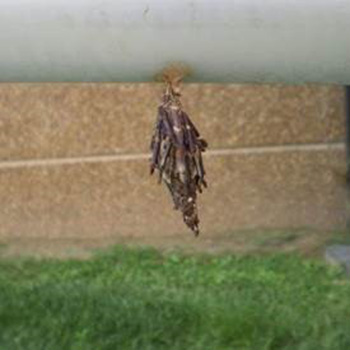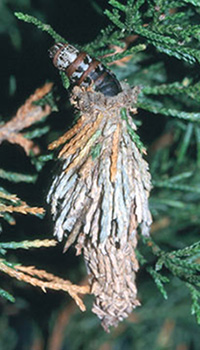Is the “Cat” Out of the Bag?: Eastern Bagworm
By The Environmental Awareness and Advisory Committee, W.A.I.T., Bill Willis and John McLamb
August 28, 2014
Sometimes things are not what they first appear, and that can cause to us to see but not recognize. Therefore, we don’t fully experience relationships around us. Who hasn’t at one time or another unknowingly let this happen. Recently one of our employees, Anne Thompson, saw something interesting and unusual (out-of-place) along the walkway to the Module E/F connector entrance. There appeared to be small, decorated ornaments about 0.5” wide and 1-2” long, hanging from the aluminum handrails along that sidewalk. One of the ornaments was moving. If on a tree, they might not have been seen or might have looked like foliage, a small pine cone, dead branch or leaves, etc. However, that wasn’t the case this day.

Photo courtesy of Anne Thompson, NIEHS
What she found were several “cat” in a bag, not to be confused with the Cat in the Hat. That’s an entirely other story.
They were “cat”erpillars in bags/sacs, commonly called eastern bagworms, Thyridopteryx ephemeraeformis. These caterpillars are often familiar pests in ornamental landscapes. Dense populations can become very destructive to trees, defoliating and eventually killing them, if this insect is not held in check some way.
The caterpillars lead a very sedimentary lifestyle and the young caterpillars (instars) usually remain on the tree of their maternal parent. These, unlike most foliage-eating caterpillars (including webworms), have developed a camouflaged and protective covering/sac to protect them from prey and the weather.
Our account begins as the young caterpillars that have overwintered as eggs, begin hatching from the egg mass in late April to early June.
Being born in the wild, they rappel away from the mass by silk threads that when aided by the winds help to disperse them. Usually the young are deposited very close to where they hatch, thereby significantly increasing the local population (infestation).

Photo courtesy of Anne Thompson, NIEHS
With the aid of a silk sac located on their posterior, young caterpillars being making the bag that will eventually enlarge as they eat and grow. Only the insect’s head and thoracic legs are exposed and visible. The sticky silk on the outside of the sac will collect plant material as they age.
Early in life, the bag points upward, but later will hang downward. What the insect is feeding on can be determined by the covering of the sac.
Since the main target trees in North Carolina are conifers (evergreen) like cedars (red), arborvitae, spruce, pine, Leyland Cyprus, most bags are covered with needles and modified leaves of these species. However, broadleaf trees like the maple, sycamore, apple, cherry, poplar, oak, etc. are also hosts to this caterpillar. The bags on the purple plum by Module E/F connector entrance bear both plum and conifer debris. This is an indication that two host trees were fed upon.
Knowing how much a hungry, hungry caterpillar eats and poops, the question arises “How does the bag stay clean inside?” Upon closer inspection in the research laboratories of NIEHS, the bag actually has openings at both ends, one for the eating parts and the other for, well, other purposes. Both were shown to work efficiently in an approved BH and G “Bag-n’-Beaker” trial (n=5).
The bagworm eats continuously from May to mid August with few breaks and no vacations. It’s during late August that the caterpillar reaches maturity, attaches its bag firmly to a limb, closes the top, flips 180o, and begins the process of pupating (metamorphosing).

Photo courtesy of Wikimedia
Metamorphosis requires about one month. Male bagworms emerge as little hairy brown moths with a big passion for companionship. The female on the other hand looks like an eyeless, wingless, legless grub that is resigned to stay in the sac for the rest of her life.
The males drawn by female pheromones actively seek out the female to mate. Due to privacy issues, no cameras were allowed in their chambers, so how he successfully copulates remains restricted information. One generally accepted thought is that if the door is left open, he’ll gain access. Needless to say, he’s usually successful and she’ll create an egg mass of between 100 and 1000 eggs. Totally exhausted and depleted, she will die within the bag. Another life cycle is ready to be repeated.
As far as control measures, the best time to remove bags is anytime they’re seen. Parasitic wasps, hornets, woodpeckers, and sapsuckers help in control, but the bags are too strong and difficult to open for most predators. In the fall the bags can be seen on deciduous trees as the leaves fall (the bags don’t). On conifers, the bags turn gray-brown and can be seen against the green background. Several years’ worth of bags may remain, so it’s important to monitor and pull all bags to access the true scope of the infestation. Some of the bags will be empty (previous years or male) but others will contain the eggs to hatch next spring.
Mr. Johnson, NIEHS’s Landscape Contractor doesn’t consider bagworms a problem at this time. He sees them occasionally on the crabapples but no campus-wide control measures are warranted. If you decide to control in your own landscape, destroy bags rather than putting them into yard waste or throwing on the ground for you may just spread the problem. A bacterial spray (Bacillus thuringiensis kurstaki, a.k.a. B.t.) that affects caterpillar digestion is good at the instar and early growth stages and it won’t harm other insects. Once mature or in the pupa cocoon, insecticides are minimally effective or beneficial.
If you have personal observations or comments, please send them to us. Other subject topics are always appreciated.
Referenced Sources



